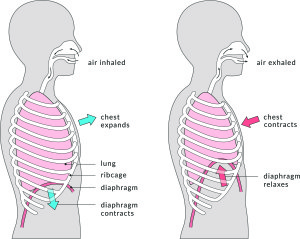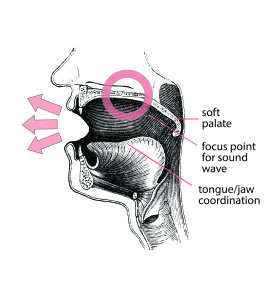Freeing the voice
A physical therapy analogy
The current series of WTL articles is a potpourri of practical items for pastors, musicians, and worship planners. Here’s an article that is valuable equally for pastors who speak (and sing) and for choir directors, cantors, soloists. It contains a wealth of practical advice—advice, however, that may be rather technical, causing the reader to wonder if improvement can come without coaching. Some ideas will be helpful without much struggle. Some will require focused attention. Some might prod the speaker or singer to seek assistance from a qualified vocal coach. The online videos mentioned on page four can be helpful.
Think of a person experiencing shoulder trouble. The physical therapy solution requires doing just the right exercises in just the right way. Correct form and weight are critical to resolve the problem and avoid further pain or damage. – Bryan Gerlach
Freeing the Voice
A pastor once shared with me the vocal challenges he faced each week. He preached for the early service, taught a Bible class, and then preached for the second service. Add to this an evening service during the week and other classes. He developed a hoarse voice each week in his attempt to communicate emotion by raising and lowering his pitch. This left him wondering what he was doing incorrectly as he projected his voice.
In the past two years I have worked with two called workers who were seeking to take voice lessons to correct their vocal technique. Their voices were tight, sore, and exhausted. I found one common thread while working with both pastors and a Lutheran elementary school teacher. Their overall body tension and unregulated air flow caused them to “over” sing or speak in order to project their sound. One pastor needed complete vocal rest during the week. The teacher had to wear a microphone while speaking in the classroom.
The point to these stories is that many people experience faulty vocal techniques and are unsure how to correct them. This article offers guidance to help you “free your voice.”
A voice teacher once told me, “The human voice is the only instrument that you have one opportunity to care for. If you damage your voice, you do not have the opportunity to replace it.” This is an important concept for us who use our voices to the glory of God both in worship and for our profession. We need to use our voices in a healthy manner each time we sing or speak.
What does healthy mean?
Healthy means using your voice to the best of your God-given ability. It’s a stewardship issue similar to other ways we take care of the body and health that God has given us: diet, exercise, rest. The goal is a healthy voice for a lifetime of faithful use and service. You can accomplish this goal by understanding the anatomy involved in freely resonating your voice.
Healthy means using your voice to the best of your God-given ability.
Alignment
Good alignment in how you stand or sit can affect how your body produces a singing or speaking tone. Poor alignment can cause undue pressure on your larynx (voice box). Alignment starts by lengthening your spine which will in turn release tension in your lower back muscles. This happens because the abdominal and lower back muscles are supporting your skeletal structure. You help the breathing process by widening your shoulders and allowing your rib cage to expand. You reduce tension in the muscles where your skull and vertebra are connected by lengthening them along the back of your neck. This lengthening also allows your chin to stay level with the floor as you produce vocal tone. Your vocal tract works freely and consistently when you take time to align yourself.
Breathing
Well-supported breathing is another area that needs to be addressed in order to free the voice. Irritation in the vocal folds and cords may be caused by too much air being expelled while singing or speaking. Expelling too little air produces a harsh tone in your voice. This is sometimes referred to as a “glottal attack.” Both techniques—too much or too little air—can cause serious and even permanent damage.
How can you regulate air flow while singing or speaking?

Diaphragm illustration
The diaphragm is an important muscle that separates your abdominal muscles and your thoracic cavity (the area that contains your heart and lungs). What does your diaphragm do? It is a muscle that is involved during the inhalation process of your breathing. If you release your lower abdominal muscles in an outward and forward motion, your diaphragm would contract (drop down as the abdominal muscles are displaced outward). Your body then would naturally form a vacuum which draws the air into your lungs. As you sing or speak, your diaphragm relaxes in an upward motion and eventually rests in a domed shape under your rib cage. Your abdominal and lower back muscles slow down the process of your diaphragm returning to its resting position. This process supports your vocalization and evens out your airflow.
An exercise that you can use to perform “diaphragmatic” breathing begins with proper alignment. After your body is aligned, blow air through your mouth as if you are trying to cool off a warm beverage. At the same exact time, you should feel your abdominal muscles relaxing upward toward your ribcage as the air is leaving your body. It’s as if the air is slowly leaking out of a balloon while it deflates. Inhalation begins by releasing your lower abdominal muscles and allowing the navel to spring outward. As this happens, air will quietly enter the lungs through your nose and mouth. You are harnessing your air and are ready to support your vocal tone. This process should continue through each vocal phrase.
Resonance
Many people believe if we use more air, we produce more sound. It is not the amount of breath that determines whether we are heard at the back of the room. What matters is how we use that breath, combined with the skill of developing natural resonance.
Resonance is defined as amplification of the original sound. Natural resonance allows a person to carry their vocalization over the space they are trying to fill. The path of resonance begins with an even airflow through the larynx. The larynx makes a buzzing sound which travels up the back of the throat to the mouth. Three areas in the mouth that affect your vocal tone are the soft palate, the hard palate, and the tongue. The soft palate is the soft tissue constituting the back of the roof of your mouth. The hard palate is the dome-shaped roof of your mouth. It is a sensitive surface that can be a focal point for the sound wave arising from the vocal folds. This is the area where the sound wave converts into vocal tone. The sensitivity of the hard palate is a very useful tool for enhancing the speaking voice when lecturing or preaching, and it is essential for singing.
Freeing up space between the tongue and the hard and soft palates is the key to making resonance successful. This space allows vocalization to amplify without adding tension or stress to the vocal tract. Your vocal tone exits your body through two areas: your mouth and your nose. Here are some issues that can develop bad vocal habits and also how to correct them.
MOUTH – Vocal tone is distorted or strained if the tongue is pulled back and away from the opening of your mouth. The tongue arches upward toward the back of the throat. This improper use of the tongue is visible when the pitch of your voice is in the higher range of singing or speaking. You can see space between the tip of the tongue and the lower front teeth. This unnatural position will lift the larynx into a higher position in your throat because of connective tissue and ligaments. This is detrimental to your overall vocal health. In choirs, you may see an indicator of this when people lift their eyebrows while singing. One obvious visual cue that a director can notice is when singers lift their chins and you see the muscles straining around the larynx. This usually happens in an attempt to sing higher pitches in the vocalist’s range. If a public speaker or singer continues to use their higher range in this manner, they will develop permanent damage to their voice.
How do you correct this misuse of the tongue and larynx?
You need to connect coordination between the tongue and the jaw. The goal is to relax the tongue and allow it to lay flat in a neutral position across the lower teeth and jaw. The tongue should be as “flat as the state of Texas”—both broad and wide. Each time the jaw releases to vocalize vowels, the tongue should move fluidly with the lower jaw. This assures that the larynx remains in a low position and is relaxed while singing and speaking. A recommended exercise to build tongue and jaw coordination is “Hee, ah.” The tongue lies flat in the mouth as you fluidly move the jaw between the vowel sounds of “ee” and “ah” (Example 1). You ascend each time you sing the phrase by half-steps.

Example 1
NOSE – Vocal tone sounds nasal if you allow the sound wave to travel through the nasal cavity and the mouth.
How do you close off the area to the nose so that the sound wave is distributed through the mouth?
The soft palate needs to be lifted to close off resonance through the nasal cavity. It is like a trap door. The sound wave will travel directly to the hard palate if the soft palate is lifted. An easy way to lift the soft palate is to say the word “hung.” Now add the syllable “ah” after the word hung, which sounds like “hung-ah”. You will feel the soft palate lift and lower itself in the back of your hard palate. The “Ng” hum is an exercise used to strengthen the soft palate to stay in an upright position. Pick a neutral pitch. I suggest G below middle C for the men and G above middle C for the women. Sing the word “hung” and hold the “ng” sound as you descend down the 5 note scale. Keep the tongue flat and relaxed in the bottom of the mouth. This is very important. (Example 2)

Example 2
This exercise develops the ability to keep the soft palate lifted in a dome shape across the back of the throat. By simply learning to include an appropriately domed soft palate in every vowel shape, the singer or speaker can close off the resonance through the nose and de-nasalize the voice.
Resonance is the end result of a developmental process. It is not something we either have or don’t have. We can build a resonant singing or speaking voice. Opening your vocal tract by freeing up the space in your mouth will allow you to resonate naturally, easily, and fully across the space that you are trying to fill with sound. This illustration shows what an open vocal tract looks like.

Path of Resonance
Summary
A review of the information above in a simplified manner is as follows:
- Align your body
- Utilize diaphragmatic breathing to even out the airflow which passes through the larynx
- The larynx buzzes producing a sound wave
- The soft palate should be lifted
- The tongue should be flat and relaxed, moving fluidly with the jaw over vowel sounds
- The sound wave is focused on the hard palate and converts to vocal tone
- Vocal tone resonating from the hard palate allows sound waves to travel through the mouth and amplifies the voice in a relaxed manner
These seven components take time and practice to coordinate. Each one is essential to opening up the vocal tract and “freeing the voice.” Together they will allow you to resonate efficiently and to the best of your God-given ability. If you do have vocal issues that cause discomfort or pain, please seek medical assistance. Do not wait. You have been given only one voice to use for God’s glory. God bless your continued efforts in sharing the Gospel through Word and song.
By Natosha Cole
Natosha Cole is a voice teacher and the Cantate Choral Director at Manitowoc Lutheran High School with over 20 years of experience teaching voice. A member of the distinguished National Association of Teachers of Singing, she is a 1996 graduate of Martin Luther College and studied vocal performance at Arizona State University.
Additional resources
Natosha Cole provides video content at the link below. If you are accessing this from a paper copy of WTL, search YouTube for the title: Improving Vocal Resonance and Freeing the Voice (https://www.youtube.com/watch?v=CfnGFSKA6MI)
The first 15 minutes explore concepts described above. Then follows additional content especially helpful for singers and choir directors. Two additional videos are available on YouTube from presentations to WELS choir directors.
The Voice – Pedagogy and Technique
Choral Director and Voice Teacher: Working Together
Four resources from Natosha Cole shared at the 2014 conference are available at worship.welsrc.net. Follow the “Worship Conference” link and then click on “2014 Conference on Worship, Music, and the Arts” to open up a list of all available handouts.
See also under “Worship the Lord Newsletter” numbers 53 and 54 in the series “Challenges for the Lutheran Church Choir.”
Preacher testimonial
I remember occasionally having a sore voice after preaching. The main reason I sought voice coaching, though, was because I wanted to become a better singer.
I was amazed at what voice lessons did for me over time. I didn’t know how to “sing from the diaphragm.” But voice lessons helped me to understand and put that concept into practice. I’m still a novice. But after practicing for a year, I can feel the air expand my ribcage when I breathe in. I’ve learned to regulate the exhale. In choir I’ve noticed a dramatic improvement. I can sing more than one line without taking a second breath. Singing high notes is also easier.
Voice coaching has taught me that the proper use of my voice does not require major effort. To sing or speak loudly, I used to make the effort from my throat. Now, I simply let the air release from my ribcage, open my mouth wider, and the sound comes out louder. Through voice lessons, I now appreciate that my voice is like a natural wind instrument.
Besides singing improvement, I feel the timber of my speaking voice has improved. To my ears, my voice sounds richer. Since voice lessons, I have not had a sore voice from preaching. I highly recommend voice training for called workers.
Teacher testimonial
About six years ago, I began experiencing pain in my vocal cords and dealt with voice loss almost every month. I would feel relief on the weekends. But after an hour of teaching on Monday morning I would begin losing my voice again and feel the pain in my vocal cords. Even normal talking in conversations became difficult. After seeing an ear, nose and throat specialist, who informed me I will always struggle with swollen vocal cords, I decided my last option was voice lessons. I took one year of voice lessons and faithfully did the exercises needed to improve breathing habits and to relieve tension as I sing or speak. Lessons were once a week, and I was able to go the entire year without losing my voice. I could project more, and it was easier for me to be heard.
But now this year my schedule does not allow time for the lessons, and I am struggling with chronic voice loss and the pain of swollen vocal cords again. I have not been consistently using the exercises this year.
There is definitely a correlation between strength of voice and exercises for it.



